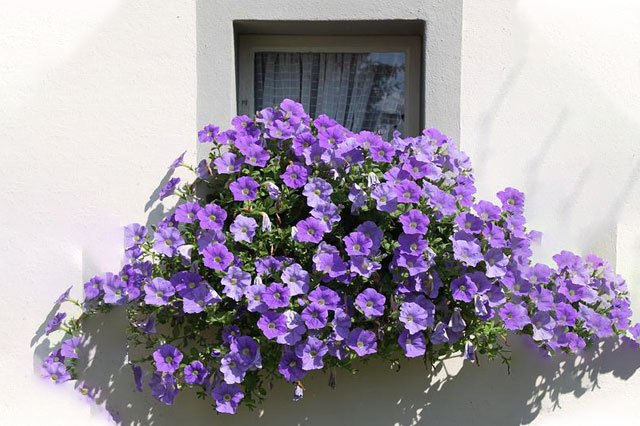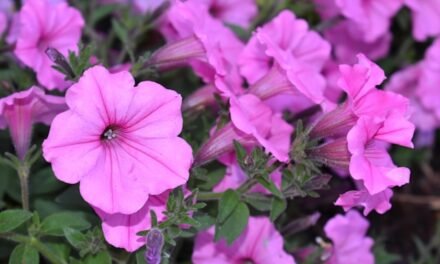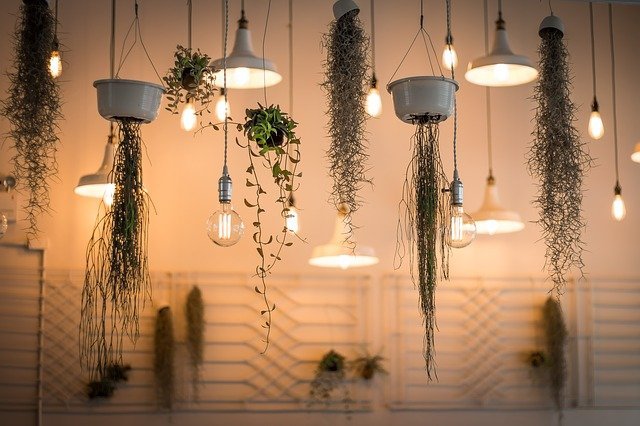House plants have become a compulsory part of our homes. But your little indoor nursery does not have to be all green! If you are inclined towards sublime upgrades, go for purple house plants to amp up your plant game!
The purple color stands for royalty and elegance. The range of shades in purple house plants is so wide that you will never get bored of them! Whether you decide to go all purple or just shades of violet, this splash of color will create a visual appeal and represent your unique style and taste.
Now, for your convenience fam, we have divided purple indoor house plants into 2 categories:
- House plants with purple leaves
- House plants with purple flowers
House plants with purple leaves
The best types of purple house plants with striking purple foliage are
Purple Shamrock
Botanical Name: Oxalis Triangularis

Oxalis triangularis is the highlight of indoor purple house plants. Its fancy dark purple foliage, with shades of magenta, will leave you delighted all year round.
Note: Purple shamrocks have a very interesting history. Their origin is linked to the day when St. Patrick explained the concept of Trinity to the Irish people by using this peculiar plant! This is why you see these being sold abundantly around Saint Patrick’s Day.
This easy-to-grow purple house plant is ideal for the black thumbs among you!
Tip: Place it on side tables or white countertops for an ethereal look. Purple shamrock is included in the rare purple house plants list, with a 1-foot height, it will look perfect when placed on an elevated space.
Growth requirements:
- Soil:
Sandy or loamy soil of a slightly acidic nature. It should be well-draining. - Temperature and humidity:
A temperature of 60 to 75°F and moderate humidity level is needed for it - Light and water:
This purple house plant loves moderate light and evenly moist soil. - Nutrition:
Add a slow-release fertilizer during cool seasons i.e., fall, winter, and spring.
Rex Begonia
Botanical Name: Begonia Rex-cultorum

Are you looking for a large-leaved purple house plant? Then Rex Begonia will be ideal for you. A native of Southeast Asia, this purple house plant creates stunning mounds of purple and deep green heart-shaped foliage. It reaches 10 to 12 inches in length.
Note: This purple indoor house plant produces white or flushed pink blooms in summer. But remember bruh! Their flowers drain away the energy from leaves leading to an excessive leaf falling. Cut them off if you want to retain the stunning dual-shaded leaves!
Growth requirements:
- Soil:
Well-draining rich potting mix - Temperature and humidity:
Approximately 50% humidity level and 65 to 75°F temperature is ideal for begonia - Light and water:
Although it’s photophilic, direct sunlight can damage the leaves. Bright, indirect light exposure and consistently moist soil. - Nutrition:
Give diluted fertilizer during the growth period(i.e., warm season)
Ti plant
Botanical Name: Cordyline Fruticosa

Ti plant or cabbage palm is notoriously famous for its religious and medicinal link. Being considered as a symbol of good luck, you will find this purple house plant abundantly in people’s homes. Ti plant boasts deep purple-red to fuschia colored blade-like leaves. It can reach up to 10 feet in length and doesn’t require much attention (Phew!)
Growth requirements:
- Soil:
Slightly acidic sandy loam soil - Temperature and humidity:
65 to 95°F and high humidity is ideal (Remember: the type of humidity that will make you sweat is the one that makes the Ti plant flourish!) - Light and water:
Filtered light and water continuously in the growing season for an evenly moist soil - Nutrition:
Slow-releasing fertilizer during the growth period.
Prayer plant
Botanical Name: Maranta Leuconeura
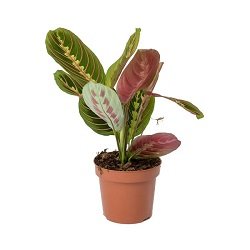
The name ‘prayer plant’ comes from the iconic behavior of such plants. They open their leaves in the morning and make their leaves upright in the evening, resembling our hand gestures during prayer! The showy leaves of the prayer plant have indigo veins and a rich purple underside. (It looks snatched in real life!)
Prayer plants are fairly easy to grow and reach 1 foot in height at maximum.
Note: The ideal location for these plants is bathrooms and kitchens which are humid and low lit as compared to other rooms.
Growth requirements:
- Soil:
Neutral to acid soil, it must be well-draining. - Temperature and humidity:
65 to 85°F and high humidity levels have to be maintained (Invest in a good humidifier ASAP!) - Light and water:
Not an avid lover of the sunlight, it thrives in partial or full shade. Water it regularly to keep the soil moist. - Nutrition:
Add half-strength fertilizer fortnightly from spring to fall.
Persian shield plant
Botanical Name: Strobilanthes Dyeriana

Have you ever laid eyes on this bladed beauty? If not, then you are missing out big time! The elegant vivid purple leaves with deep indigo veins are what make this plant extraordinary. (Trust us bro, when you see it, you will find yourself second-guessing whether it’s real or not.)
This Mayanmar origin beauty is a fairly low-maintenance 3 to 4-foot tall purple house plant, so don’t worry about affecting its signature metallic leaves with your negligence!
Growth requirements:
- Soil:
It requires a neutral to slightly acidic soil that retains moisture well and is rich in nutrients - Temperature and humidity:
60°F is the ideal temperature. Maintain high humidity levels by a mystifier - Light and water:
Partial shade works best with Persian shield plants. Use filtered like warm water for watering - Nutrition:
Once in spring and summer.
Wandering Jew
Botanical Name: Tradescantia Zebrina

Your search for hanging purple house plants is now over! Wandering Jew is a 12-inch tall plant that produces deep violet new leaves which transform into a dark green shaded variety with a purple underside on maturation. It also produces purple flowers, thus making it a purple flower house plant too! (Planting a Wandering Jew is how you kill two birds with one stone!)
Growth requirements:
- Soil:
Loamy soil that is well-draining and nutrient-rich - Temperature and humidity:
55 to 80°F and average humidity is required here. - Light and water:
Bright, indirect sunlight and regular watering is needed - Nutrition:
Adding fertilizer once per month is sufficient.
Coleus purple house plants
Botanical name: Plectranthus Scutellarioides

The most iconic house plants with purple leaves belong to the family Coleus. A well-loved plant of this family is Solenostemon scutellarioides, also known as ‘Painted nettle‘. It is the only coleus plant that can be suitably grown in the room(and what a babe it is!)
This purple house plant is quite easy to grow. Their magnificent-contrasted, soft, velvety, bold leafage enhances the visual appeal and charm of this plant. Your friends and family will not be able to draw their eyes from it!
Growth requirements:
- Soil:
Any type of soil is fine as long as it has perlite and drains efficiently - Temperature and humidity:
A 70 to 100°F and moderate to high humidity level is needed for it (Do the math. You will eventually need a humidifier) - Light and water:
It craves full sun exposure and can survive in partial shade too. You need to be on your toes while watering it in summer (twice a day watering schedule works for them) - Nutrition:
Add fertilizer every week.
Purple passion
Botanical Name: Gynura Aurantiaca

Another addition to your hanging purple house plant’s category is Purple passion. This is, by far, the most lit option among purple house plants. Its eccentricity comes from its olive green velvety leaves that are loaded with bright purple fuzz at the tips. It also produces orange-yellow blooms in summer. Being just 1 to 2 feet tall, rest assured that it will not overwhelm your indoor plant display by its size.
Growth requirements:
- Soil:
It should be well-draining and nutrient-rich - Temperate and humidity:
60 to 70°F and moderate humidity - Light and water:
Bright filtered light or partial shade( Remember fam: more sunlight=more purple fuzz). Water it regularly during growth season - Nutrition:
Add half-strength fertilizer dissolved in water every week during spring and summer.
Purple succulent
Botanical Name: Echeveria
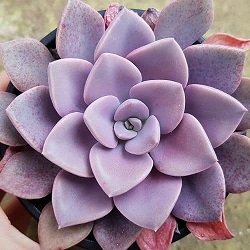
Echeveria is a family of more than 150 succulents. You can find all shades of purple in this family, ranging from periwinkle, dusty lavender to dark purple (almost black-ish). It has a rosette-shaped structure and grows effortlessly indoors. Being a succulent, it’s one of the easiest plants to maintain (TBH, too much care will actually damage it!)
Growth requirements:
- Soil:
Well draining neutral succulent potting mix - Temperature and humidity:
Warm temps and low humidity - Light and water:
They are extremely photophilic; make sure that they have bright, direct sun exposure. Water when the soil is dry. - Nutrition:
Add fertilizer once a year.
Ruby Necklace
Botanical name: Othonna Capensis

This stunner is not only trailing succulent, but it can also be grown indoors! (We guarantee, you will be shooked when you see it!)
The sheer beauty of trailing green and indigo bean-shaped bulbs is enhanced when bright yellow daisy-like flowers bloom. Look no further than the Ruby Necklace if you want hanging purple house plants.
Growth requirements:
- Soil:
Neutral well-draining succulent mix - Temperature and humidity:
Warm temperature and low humidity works best for them - Light and water:
Water when the soil is dry. Bright, indirect sunlight such as that of early morning sun is ideal - Nutrition:
Once or twice a year
Purple Heart
Botanical Name: Tradescantia Pallida ‘Purpurea’

A melony of purple house plants, Purpurea will steal your hearts in just one look! This rare purple house plant has lush bright purple foliage that has subtle hints of turquoise in it (it darkens as it matures!) Watching this captivating play of colors is a fetish in itself. Its beauty is further enhanced when it blooms vivid pink flowers in summer
Growth requirements:
- Soil:
Loamy sand (it should be neutral) - Temperature and humidity:
Tolerates high temperatures once established, moderate humidity required - Light and water:
Full sun exposure or partial shade. Water regularly during dry spells. - Nutrition:
Add fertilizer monthly during the growth period.
House plants with purple flowers
The best purple flower house plants are:
Cyclamen
Are you on a hunt for purple flower house plants that bloom in the cold season? Cyclamen, a mere 9 inches plant, will be ideal for you then. Not only does it produce charismatic purplish violet flowers, but it also blooms through fall to spring (Whaaat?!)

Yes, my friend, you read it right. Cyclamen will be your beloved purple flower house plant for the winter. Even its leaves have purple undersides! (A treat for yourself in winter is good now and then fam!)
Beware: Do not fall for the cuteness of this petite plant! It’s a death sentence to everyone you can think of i.e. your furry friends and even humans too!
Growth requirements:
- Soil:
Acidic loamy sand soil - Temperature and humidity:
A night temperature of 40 to 55°F and day temperature of 60 to 80°F is optimal. Maintain high humidity throughout the day. - Light and water:
Partial shade or bright indirect light. Water it enough to keep the soil moist. - Nutrition:
Slow-releasing, low-nitrogen fertilizer from fall to spring.
Gloxinia
Being a tropical plant, its lush green foliage and bell-shaped flowers are a sight to behold. This modest 10 to 12 inches plant has spades like leaves and lavender to deep-violet colored blossoms that add depth and drama to any indoor collection they are added to!
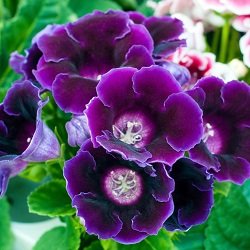
Note: Do not confuse these African violets! They are both quite similar in appearance.
Growth requirements:
- Soil:
A gardenia potting mix that is loose and well-draining works ideally for them. - Temperature and humidity:
70 to 85°F temperature and high humidity are required (Remember what we told you earlier about high humidity? The one that makes you sweat is the best!) - Light and water:
This purple house plant needs a filtered bright light source and consistently moist soil - Nutrition:
Monthly water-soluble fertilizer addition
Purple Vanda Orchid
The species of Vanda that produce purple flowers are:
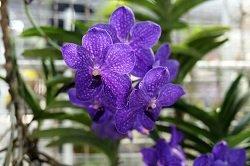
- Vanda coerulea
- Vanda pachara
- Vanda sansai blue
- Vanda mokara
- Vanda Robert’s delight
Their flowers’ colors are a mix of violet and indigo hues. These house plants with small purple flowers have slender stalks and require an old bark to grow (a regular for orchids).
Growth requirements:
- Soil:
Soil-less bark or peat moss that is well-draining works fine for them (This is a great escape from the regular potted plants! Place this lit orchid growing on bark on top of your desk and watch it evolve.) - Temperature and humidity:
60 to 85°F temperature and high humidity level flourishes this purple flower house plant. - Light and water:
Partial shade or filtered light is needed for its survival. Water frequently but do not let the water stand. - Nutrition:
Weekly in the growing season and once a month during the winter.
Christmas cactus
Botanical Name: Schlumbergera
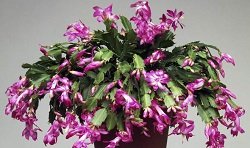
Although a cactus, this unique house plant with small purple flowers will augment the beauty of your living space. Its blooms are of a spectacular tubular shape and are sweetly scented.
Its pad-like lush green foliage will make you fall in love with it. Just like other cacti, Christmas cacti are very easy to maintain and entirely nontoxic. This makes it an ideal indoor purple houseplant that you can gift to your friends and family that have little kids and furry friends in their homes.
Growth requirements:
- Soil:
Well draining soil that is neutral or slightly acidic - Temperature and humidity:
60 to 85°F temperature and high humidity levels are required. - Light and water:
Place it at a place with access to bright filtered light. Water it ONLY when the soil dries. - Nutrition:
Add fertilizer monthly before and after the blooming process.

